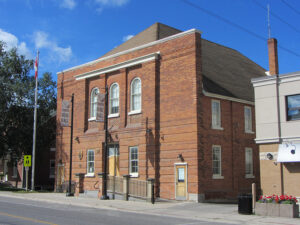Uxbridge Remembers: Col. Samuel Simpson Sharpe
One of the many displays of remembrance sits atop a slope overlooking the intersection of Toronto Street North and Brock Street West, gazing across the streets at the Cenotaph. Although a relatively new addition to Downtown Uxbridge, its impact is a strong one.
The bronze statue of Col. Samuel Simpson Sharpe was commissioned by the Uxbridge-Scott Historical Society and the Township of Uxbridge to commemorate the life, legacy and years of service of Sharpe, whose legacy had been all but swept under the rug for almost 100 years.
A local war hero.
Born on March 13th, 1873 in Zephyr, Ontario, Sharpe spent his childhood and teenage years in Uxbridge. When he was 16, Sharpe joined the 34th Ontario Regiment and went on to study political science at the University of Toronto. Sharpe graduated in 1895 and became a well-known lawyer in Uxbridge while also rising to the rank of Major, and becoming the 2nd-in-command of the 34th Regiment.
By 1908, Sharpe was fully involved in Canadian politics. He was elected as a Conservative Member of Parliament for the (former) riding of Ontario North, and he was reelected in 1911. At one time, Prime Minister Robert Borden had short-listed Sharpe to become the National Minister of Militia and Defence, but the job ultimately went to another militia officer who Sharpe considered his biggest rival.
When the Great War broke out in 1914, Sharpe stood ready for his chance to lead. By November of 1915, he was finally given permission to develop the 116th Battalion infantry unit, and was eventually promoted to lieutenant colonel and appointed as the unit’s commanding officer. Sharpe personally recruited young men from the 34th battalion and his hometown of Uxbridge to serve alongside him.
His 116th Battalion saw much action in the first few years at war, fighting at the Battles of Vimy Ridge and Passchendaele, and a raid at Avion amongst others. In 1917, Sharpe sought re-election to Parliament while still on the battlefield, and claimed victory by earning almost twice the amount of votes of his opponent. For his leadership in the Great War, Sharpe was awarded the Distinguished Service Order (DSO) for bravery.
A hero’s burden.
Sharpe’s courage was outstanding, but the horrors he had witnessed and personal losses he had experienced impacted him deeply. Sharpe wrote to many families of soldiers that died under his command, feeling personally responsible for their deaths since he had recruited many of them. Out of the 1,100 soldiers he recruited, only 160 were still on active duty when they returned to Canada.
Not long after he received the DSO from King George V, Sharpe’s mental health took a steep decline and was admitted to a hospital in England after suffering a nervous breakdown. He was then placed on leave and sent back to Canada.
After arriving back in Canada, Sharpe’s mental health took a turn once more. While he was travelling back to Uxbridge via train, he suffered another nervous breakdown and was admitted to the Royal Victoria Hospital in Montreal. While in the hospital, Sharpe was diagnosed with what was then called “shell shock,” now known as Post-Traumatic Stress Disorder, or PTSD.
The horrors that Sharpe had witnessed on the battlefield along with the loss of many of his comrades and friends proved too much to bear.
On May 25th, Sharpe plunged to his death from his fourth-floor hospital window. He was 46. Those close to Sharpe believed that he could not stand the thought of returning to Uxbridge and facing the families of those who had died under his service.
Upon his death, Sharpe became one of only two sitting Canadian MPs to die while in military service. He was laid to rest with full military honours in Uxbridge, four days after his tragic death.
A century forgotten, forever remembered.
Due to the stigma and general lack of knowledge of mental health in the early 1900s, Sharpe was unfairly considered to be weak and written off as a disgrace to many in his regiment and the Canadian public. This stigma largely contributed to Sharpe’s legacy going unnoticed for almost a century.
However, by 2015 the attitude surrounding Sharpe’s death had changed. Led by MP and then Minister of Veterans Affairs Erin O’Toole, a campaign to officially recognize Sharpe’s service was launched. A bronze plaque of Sharpe was commissioned and finally installed in Parliament in 2018.
Following suit, the Uxbridge-Scott Historical Society decided it was well past time to honour the Uxbridge native that had dedicated his life to service.
With the help of a $70,000 grant from the Federal Government’s Department of Canadian Heritage, and another $70,000 raised and donated by members of Sharpe’s beloved hometown of Uxbridge, a bronze statue was commissioned by the USHS and created by local sculptor Wynn Walters. The statue was formally unveiled on Friday, May 25th, 2018 – exactly 100 years after Sharpe’s death.
Sitting kitty-corner to the Cenotaph, the larger-than-life statue shows Sharpe sitting in a reflective pose as he contemplates writing to the wife of one of his fallen soldiers. He is seen with one foot resting off the ground on a rock, a sculpture tradition that indicates the subject died in battle. Though subtle, the effect is powerful — Sharpe did not die in battle, he died as a result of the battle he fought for the freedom of all Canadians past and present. And for that, Canadians, and especially Uxbridgians, will always remember him.

Photo courtesy of Veterans Affairs Canada, Canadian Virtual War Memorial

Photo by Uxbridge Daily

Photo by Uxbridge Daily







